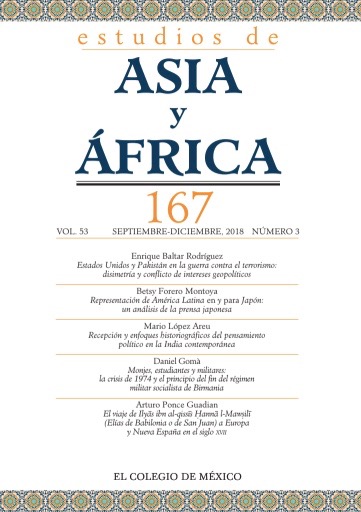Abstract
In this article, we analyze the iconographic and narrative features of the Japanese manga X (Ekkusu) created by clamp, published in Mexico by Editorial Vid between 2003 and 2005. We propose that the X manga has elements of the postmodern aesthetic in its history and graphics, with a focus on some religious aspects, shown in the hybrid manga way. This work is based on the iconographic analysis of the work, informed by the ideas of Omar Calabrese in Neo-Baroque. A sign of the times, and Fredric Jameson’s Cultural turn: selected writings on the postmodernism.
References
Referencias bibliográficas:
Hemerografía
CLAMP, X, México, Editorial Vid, 2004, Tomo 1.
CLAMP, X, México, Editorial Vid, 2004, Tomo 9.
CLAMP, X, México, Editorial Vid, 2004, Tomo 11.
CLAMP, X, México, Editorial Vid, 2004, Tomo 12.
CLAMP, X, México, Editorial Vid, 2004, Tomo 13.
Bibliografía
CALABRESE Omar, La era Neobarroca, Madrid, Cátedra, 1989.
ECHEVERRÍA, Bolívar, La modernidad de lo barroco, México, Era, 2000.
ELIADE, Mircea, El mito del Eterno Retorno, Buenos Aires, Emecé, 2001.
ELIADE, Mircea, Historia de las creencias y las ideas religiosas II, Buenos Aires, Paidós, 1999.
ELIADE, Mircea, Mito y realidad, Barcelona, Labor, 1983.
FALERO Folgoso Alfonso, “La mitología como fuente del imaginario japonés: leyenda y arquetipos culturales” en Fernández M et al, Mitologías del imaginario japonés, Diputación provincial de Soria, Universidad de Valladolid, 2007.
GARCÍA Canclini Néstor, Culturas híbridas, México, Mondadori, 2009.
GARCÍA García Francisco de Asís, “El Crismón”, en Revistas Digital de Iconografía Medieval, Universidad Complutense de Madrid, Vol. II, Núm, 3, 2010.
GRUZINSKI Serge, El pensamiento mestizo, Buenos Aires, Paidós, 2000.
JAMESON, Fredrick, El giro cultural, escritos seleccionados sobre posmodernismo, Buenos Aires, Manantial, 1998.
KISALA, Robert Kisala, “ Nostradamus and the Apocalypse in Japan”, en Inter-Religio, Núm, 32, 1997.
MONREAL y Tejeda Luis, Iconografía del cristianismo, Barcelona, Acantilado, 2000.
RANKE, Heinemann Uta, “La doble predestinación de Calvino”, en Juan Calvino, su vida y obra a 500 años de su nacimiento, Barcelona, Clíe, 2009.
SANIZ Balderrama Ligia, “Esquema actancial explicado”, en Punto cero, Bolivia, Vol. 13, Núm. 15, 2008.
SANTIAGO, José Andrés, Manga, del cuadro flotante a la viñeta japonesa, Vigo, Digital and Graphic art Research, 2013.
Santa Biblia. Versión de Casiodoro Reina (1569) Revisada por Cipriano Valera (1602) -Revisión 1960. Philadelphia, Pensilvania, USA: Sociedades Bíblicas en América Latina, National Publishing Company.
TANAKA, Michiko, Historia mínima de Japón, México, El Colegio de México, 2011.
WIKENHAUSER , Alfred, El Apocalipsis de San Juan, Barcelona, Herder, 1979.
ZHAO , Qiguang, A study if dragons east and west, Nueva York, Peter Lang, 1992.
Referencias electrónicas:
BOYLE, Kirsty, Karakuri. Info, 14 enero 2008, (http://www.karakuri.info/index.html, fecha de consulta 23 octubre 2015).
CID, Lucas, Fernando, “El arte de los autómatas japoneses”, en La ratonera revista asturiana de teatro, febrero 2012, (http://www.la-ratonera.net/?p=1758, fecha de consulta, 23 de octubre 2015).
“El Apocalipsis”, en Iglesia.net, (http://iglesia.net/biblia/libros/apocalipsis.html, Consultado el 17 de septiembre del 2013).
“Profecías de Nostradamus sobre el fin del mundo”, en Profecías y ´profetas, 17 febrero del 2013, (http://www.profeciasyprofetas.com/nostradamus_finmundo.php, Consultado el 17 de septiembre del 2013).
This work is licensed under a Creative Commons Attribution-NonCommercial-NoDerivatives 4.0 International License
Copyright 2022 Estudios de Asia y África


